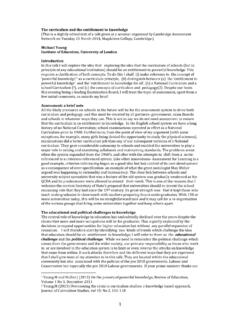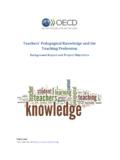Transcription of Organizing Instruction and Study to Improve Student ... - ed
1 Organizing Instruction and Study to Improve Student Learning IES Practice GuideNCER DEPARTMENT OF EDUCATIONO rganizing Instruction and Study to Improve Student LearningIES Practice GuideSEPTEMBER 2007 Harold Pashler (Chair)University of California, San DiegoPatrice M. BainColumbia Middle School, IllinoisBrian A. BottgeUniversity of Wisconsin MadisonArthur GraesserUniversity of MemphisKenneth KoedingerCarnegie Mellon UniversityMark McDanielWashington University in St. LouisJanet MetcalfeColumbia UniversityNCER DEPARTMENT OF EDUCATIONThis report was prepared for the National Center for education Research, Institute of education Sciences, under contract no. ED-05-CO-0026 to Optimal Solutions Group, LLC. DisclaimerThe opinions and positions expressed in this practice guide are the authors and do not necessarily represent the opinions and positions of the Institute of education Sciences or the Department of education .
2 This practice guide should be reviewed and applied according to the specific needs of the educators and education agencies using it and with full realization that it represents only one approach that might be taken, based on the research that was available at the time of publication. This practice guide should be used as a tool to assist in decision-making rather than as a cookbook. Any references within the document to specific education products are illustrative and do not imply endorsement of these products to the exclusion of other products that are not Department of education Margaret Spellings SecretaryInstitute of education Sciences Grover J. Whitehurst DirectorNational Center for education Research Lynn Okagaki CommissionerSeptember 2007 This report is in the public domain. While permission to reprint this publication is not necessary, the citation should be:Pashler, H., Bain, P.
3 , Bottge, B., Graesser, A., Koedinger, K., McDaniel, M., and Metcalfe, J. (2007) Organizing Instruction and Study to Improve Student Learning (NCER 2007-2004). Washington, DC: National Center for education Research, Institute of education Sciences, Department of education . Retrieved from report is available for download on the IES website at Formats On request, this publication can be made available in alternative formats, such as Braille, large print, audiotape, or computer diskette. For more information, call the Alternative Format Center at (202) 205-8113. ( iii ) Organizing Instruction and Study to Improve Student LearningContentsPreamble from the Institute of education Sciences .. vAbout the authors .. ixDisclosures of potential conflicts of interest .. xOrganizing Instruction and Study to Improve Student learning .. 1 Overview .. 1 Scope of the practice guide .. 3 Checklist for carrying out the recommendations.
4 4 Recommendation 1: Space learning over time .. 5 Recommendation 2: Interleave worked example solutions and problem-solving exercises .. 9 Recommendation 3: Combine graphics with verbal descriptions .. 13 Recommendation 4: Connect and integrate abstract and concrete representations of concepts .. 15 Recommendation 5: Use quizzing to promote learning .. 19 Recommendation 5a: Use pre-questions to introduce a new topic .. 19 Recommendation 5b: Use quizzes to re-expose students to information .. 21( iv )Recommendation 6: Help students allocate Study time efficiently .. 23 Recommendation 6a: Teach students how to use delayed judgment of learning techniques to identify concepts that need further Study .. 23 Recommendation 6b: Use tests and quizzes to identify content that needs to be learned.
5 27 Recommendation 7: Help students build explanations by asking and answering deep questions .. 29 Conclusion .. 33 Appendix: Technical information on the studies .. 35 References .. 43 List of TablesTable 1: Institute of education Sciences Levels of Evidence .. viTable 2: Recommendations and corresponding Level of Evidence to support each .. 2 Organizing Instruction and Study to Improve Student Learning( v )Preamble from the Institute of education SciencesWhat is a practice guide?The health care professions have embraced a mechanism for assembling and communicating evidence-based advice to practitioners about care for specific clinical conditions. Variously called practice guidelines, treatment protocols, critical pathways, best practice guides, or simply practice guides, these documents are systematically developed recommendations about the course of care for frequently encountered problems, ranging from physical conditions such as foot ulcers to psychosocial conditions such as adolescent Practice guides are similar to the products of typical expert consensus panels in reflecting the views of those serving on the panel and the social decisions that come into play as the positions of individual panel members are forged into statements that all are willing to endorse.
6 However, practice guides are generated under three constraints that do not typically apply to consensus panels. The first is that a practice guide consists of a list of discrete recommendations that are intended to be actionable. The second is that those recommendations taken together are intended to be a coherent approach to a multifaceted problem. The third, which is most important, is that each recommendation is explicitly connected to the level of evidence supporting it, with the level represented by a grade, , strong, moderate, and low. The levels of evidence, or grades, are usually constructed around the value of particular types of studies for drawing causal conclusions about what works. Thus one typically finds that the top level of evidence is drawn from a body of randomized controlled trials, the middle level from well-designed studies that do not involve randomization, and the bottom level from the opinions of respected authorities (see table 1).
7 Levels of evidence can also be constructed around the value of particular types of studies for other goals, such as the reliability and validity of assessments. Practice guides can also be distinguished from systematic reviews or meta-analyses, which employ statistical methods to summarize the results of studies obtained from a rule-based search of the literature. Authors of practice guides seldom conduct the types of systematic literature searches that are the backbone of a meta-analysis, though they take advantage of such work when it is already published. Instead, they use their expertise to identify the most important research with respect to their recommendations, augmented by a search of recent publications to assure that the research citations are up-to-date. Further, the characterization of the quality and direction of the evidence underlying a recommendation in a practice guide relies less on a tight set of rules and statistical algorithms and more on the judgment of the authors than would be the case in a high quality meta-analysis.
8 Another distinction is that a practice guide, because it aims for a comprehensive and coherent approach, operates with more numerous and more contextualized statements of what works than does a typical , practice guides sit somewhere between consensus reports and meta-analyses in the degree to which systematic processes are used for locating relevant research and characterizing its meaning. Practice guides are more like consensus panel reports than meta-analyses in the breadth and complexity of the topic that is addressed. Practice guides are different from both consensus reports and meta-analyses in providing advice at the level of specific action steps along a pathway that represents a more or less coherent and comprehensive approach to a multifaceted problem. Practice guides in education at the Institute of education SciencesThe Institute of education Sciences (IES) publishes practice guides in education to bring the best available evidence and expertise to bear on the types of systemic challenges that cannot currently be addressed by single interventions or programs.
9 Although IES has taken advantage of the history of practice guides in healthcare to provide models of how to proceed in education , education is different from health-care in ways that may require that practice guides in education have somewhat different designs. Even within health care, where practice guides now number in the 1 Field and Lohr (1990). PRACTICE GUIDE( vi )PRACTICE GUIDE2 American Educational Research Association, American Psychological Association, and National Council on Measurement in education . (1999)Table 1. Institute of education Sciences Levels of EvidenceStrongIn general, characterization of the evidence for a recommendation as strong requires both studies with high internal validity ( , studies whose designs can support causal conclusions), as well as studies with high external validity ( , studies that in total include enough of the range of participants and settings on which the recommendation is focused to support the conclusion that the results can be generalized to those participants and settings).
10 Strong evidence for this practice guide is operationalized as: A systematic review of research that generally meets the standards of the What Works Clearinghouse (see ) and supports the effectiveness of a program, practice, or approach with no contradictory evidence of similar quality; OR Several well-designed, randomized, controlled trials or well-designed quasi-experiments that generally meet the standards of the What Works Clearinghouse and support the effectiveness of a program, practice, or approach, with no contradictory evidence of similar quality; OR One large, well-designed, randomized, controlled, multisite trial that meets the standards of the What Works Clearinghouse and supports the effectiveness of a program, practice, or approach, with no contradictory evidence of similar quality; OR For assessments, evidence of reliability and validity that meets The Standards for Educational and Psychological general, characterization of the evidence for a recommendation as moderate requires studies with high internal validity but moderate external validity, or studies with high external validity but moderate internal validity.













